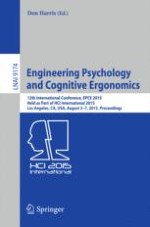2015 | OriginalPaper | Buchkapitel
The Efficiency of New Audio Alerts in the COOPANS Eurocat System
verfasst von : Peter Kearney, Wen-Chin Li
Erschienen in: Engineering Psychology and Cognitive Ergonomics
Aktivieren Sie unsere intelligente Suche, um passende Fachinhalte oder Patente zu finden.
Wählen Sie Textabschnitte aus um mit Künstlicher Intelligenz passenden Patente zu finden. powered by
Markieren Sie Textabschnitte, um KI-gestützt weitere passende Inhalte zu finden. powered by
